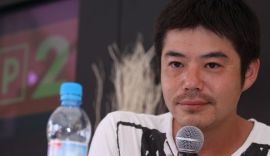Historical origami
 Three key questions that Joanna Chludzińska and Paulina Kaucz asked Jan Hřebejk
Three key questions that Joanna Chludzińska and Paulina Kaucz asked Jan Hřebejk
After the screening of ‘Kawasaki’s Rose’ at Berlinale this year, you said that your film is more Polish than Czech. What did you mean by that?
When Petr Zelenka and I come to Poland, we feel really great here especially when everybody says they love our films. Some of them even exaggerate adding that they are much better than the Polish ones.
In 1980s we valued the Polish cinema of moral anxiety. We were inspired by Kieślowski, Zanussi, Wajda, Agnieszka Holland. Those films were so close to us, we treated them as ours. At the same time in Europe Fellini, Visconti made marvelous films, but they were different from our experiences. There weren’t such films in the Czech Republic. Social problem films that criticized the contemporary situation weren’t made here then. The majority of important filmmakers were expatriates and their films were forbidden- they weren’t released, were kept in storage and had to wait for better times. Věra Chytilová and Jiří Menzel, who worked in the Czech Republic at that time, made important but too creative films.
So calling my last film ‘Polish’ I probably thought about this influence of Polish cinematography on Czech films.
What do you concentrate your attention on while making a film: on telling a story of one man or on showing the Great History?
In the Czech Republic – apart from some exceptions – we look at the Great History through individual fates. We must realize that every historical film made today is for the contemporary spectator and to a certain extent it must be a metaphor of the contemporary life.
To tell great stories, like Visconti or Wajda, you have to have talent and money. Among the best Czech historical films are Menzel’s first film ‘Closely Watched Trains’, or ‘A Shop on the High Street’, with Ida Kamińska- for me the best Czech-Slovak film of that time. I’ve seen it many times, the last time at a cinema- it’s really brilliant. I think that young generations, too young to remember those times, can understand what happened in Czechoslovakia then thanks to this film.
We know that Kawasaki’s rose is a metaphor, which unfortunately got lost in Polish translation of the title.
In the Czech Republic we also have to explain why we chose this title and what Kawasaki’s rose means. Petr Jarchovsky, whose daughter started studying Japanese, became interested in various aspects of the Japanese culture, origami among others. Kawasaki’s rose is the most difficult origami model. The film is built around different expressions and ways of perceiving the main history- just like origami. And that’s exactly what this metaphor means. In the first draft of the scripts there was even a character who created origami models, but we came to the conclusion that it would be too trivial. We changed him into a painter.









